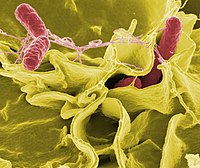
Photo from wikipedia
Abstract Bacteremia is a serious problem of public health that is caused by bacteria in the blood and their components, in this way, total asepsis is a critic aspect in… Click to show full abstract
Abstract Bacteremia is a serious problem of public health that is caused by bacteria in the blood and their components, in this way, total asepsis is a critic aspect in the different stages of transfusion medicine and in the use of biomedical devices in contact with tissues and blood. The aim of this study is to advance in the development of a new pathogen-inactivation technique by surface-contact based on the making of plasticized PVC bags with antibacterial properties. For that, films of PVC were chemically modified by nucleophilic substitution and quaternization of amino groups using dimethylamine and 1-bromoethane, respectively. Films were characterized by infrared spectroscopy, nuclear magnetic resonance, thermogravimetric analysis and elemental analysis; in addition, antibacterial properties against Gram-positive and Gram-negative bacteria (S. aureus and E. coli, respectively), hemolytic activity and surface adsorption of blood-components were evaluated. Results shown that cationic PVC, with ∼15% of quaternary ammonium groups, has antibacterial activity and hemolytic properties (hemolysis ∼7%), but also, affinity of blood-components with the surface was increased in comparison with PVC. Our results evidenced that cationic PVC can be obtained by the procedure performed, being a promissory alternative for the making of biomedical surface with capacity of pathogen-inactivation by in situ surface-contact.
Journal Title: European Polymer Journal
Year Published: 2019
Link to full text (if available)
Share on Social Media: Sign Up to like & get
recommendations!